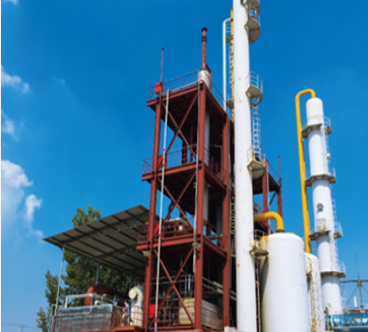生物脫硫是替代化學(xué)脫硫的一種新技術(shù),它能夠在很多方面克服化學(xué)脫硫的不足。在生物脫硫過程中,涉及兩大類微生物,即光能自養(yǎng)型微生物和化能自養(yǎng)型微生物,沼氣生物脫硫綜述了這兩大類微生物去除沼氣中H2S的可取之處!
Biological desulfurization is a new technology to replace chemical desulfurization. It can overcome the shortcomings of chemical desulfurization in many ways. In the process of biological desulfurization, two kinds of microorganisms are involved, namely photoautotrophic microorganism and chemical autotrophic microorganism. Biological desulfurization of biogas summarizes the advantages of these two kinds of microorganisms in removing H2S from biogas.
(1)在光能自養(yǎng)型微生物技術(shù)去除沼氣中的H2S方面,綠色硫細(xì)菌是一種較為理想的微生物,因?yàn)樗芾脽o機(jī)碳源,同時(shí)這種微生物的脫硫效率高,并且代謝產(chǎn)物單質(zhì)硫釋放在細(xì)胞外部,比較容易分離。
(1) Green sulfur bacteria is an ideal microorganism for the removal of H2S from biogas by photoautotrophic microorganism technology, because it can utilize inorganic carbon sources. At the same time, this microorganism has high desulfurization efficiency, and the metabolite sulfur is released outside the cell, so it is easy to separate.
但是,光和細(xì)菌在轉(zhuǎn)化過程中需要大量的輻射能,由于反應(yīng)體系中生成硫的微顆粒后,透光率將大大降低,從而影響脫硫效率,所以在經(jīng)濟(jì)條件上難以實(shí)現(xiàn)。如果能夠在降低光源的能耗和提高光源的效率方面取得突破,該方法的應(yīng)用具有廣闊的市場(chǎng)應(yīng)用前景。
However, light and bacteria need a lot of radiation energy in the process of transformation. Because the transmittance of sulfur particles in the reaction system will be greatly reduced, thus affecting the desulfurization efficiency, it is difficult to achieve in economic conditions. If breakthroughs can be made in reducing the energy consumption and improving the efficiency of light sources, the application of this method will have broad market application prospects.

(2)在嚴(yán)格控制供氧的條件下,利用化能自養(yǎng)型微生物去除沼氣中的H2S具有很廣闊的市場(chǎng)應(yīng)用前景,尤其是兩階段脫硫工藝[13,14]已經(jīng)有了工程應(yīng)用的先例(謝爾-帕克工藝)。該工藝具有不影響沼氣的回收利用,不產(chǎn)生新的環(huán)境污染等特點(diǎn)。另外,以鐵鹽吸收脫出H2S,然后用生物氧化再生鐵鹽吸收液,使鐵鹽再生的方法近年來成為新的研究熱點(diǎn)。
(2) Under the condition of strictly controlling oxygen supply, the removal of H2S from biogas by chemoautotrophic microorganisms has broad market prospects, especially the two-stage desulfurization process [13,14], which has a precedent in engineering application (Shell-Parker process). The process has the characteristics of no impact on the recovery and utilization of biogas and no new environmental pollution. In addition, the method of iron salt regeneration has become a new research hotspot in recent years, in which H2S is absorbed by iron salt and then regenerated by biological oxidation.
(3)生物脫硫技術(shù)必須具備幾個(gè)條件:,具有可靠的效率;第二,所需的營(yíng)養(yǎng)物質(zhì)少;第三,生物量中的單質(zhì)硫容易分離出來。
(3) Biodesulfurization technology must have several conditions: first, reliable efficiency; second, less nutrients needed; third, the elemental sulfur in biomass can be easily separated.
Thank you for reading and watching. The wonderful content of this article comes from biogas desulfurization. We will continue to show you more wonderful content. For more details, please click: http://www.fcw-app.com.
